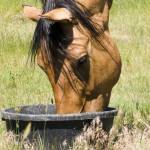Maintaining a Healthy Equine Digestive Tract: Mouth and Esophagus

Feeding management can greatly influence the health of the digestive tract for better or worse. A healthy digestive tract is an integral part of the total well-being of the horse.
Horses that are in large pastures 24 hours a day rarely suffer from colic, ulcers, and other common digestive disorders. As humans try to manipulate the horse’s diet to reach certain goals (more energy, trimmer figure, convenience, and so on), horses end up on unnatural feeding schedules that can impact their digestive tract health. Failure to understand the anatomy of the digestive tract and basic digestive physiology is the root of many feeding errors involving nutritional management.
Since the horse evolved as a grazing herbivore, much of his anatomy is adapted to the diet and eating style of that life. Many of man’s management practices have taken the horse far from the way he evolved. Therefore, a good understanding of the physiology of the digestive tract is important in order to grasp how it may influence the horse’s health and well-being.
Mouth
Paying attention to the condition to the horse’s mouth is important since that is where food processing begins. Though it is often neglected, there are two aspects in which the mouth is important in maintaining a healthy digestive tract. First, in order for food to be properly digested, it must be prepared correctly. The way to do this is by adequate mastication (chewing) of the food. If the horse is on pasture, then the incisors (front teeth) are important for the horse to be able to bite off blades of grass or other forage. For fresh grass, hay, and grain, the molars (back teeth) are important for reducing the feed into smaller particles.
With an imperfect set of teeth (which is often the case in the older horse), it is very difficult to break down the food to the appropriate particle size for ideal digestion. Second, chewing produces saliva which contains certain enzymes that start the breakdown of nutrients and help the food slide down the esophagus to the stomach. Saliva is also loaded with buffering agents that help to neutralize stomach acids. Curiously enough, a horse produces close to twice as much saliva chewing on hay as when eating grain. This may be due to the horse having to chew longer on forage than on grain.
What can go wrong. If the teeth are not meeting correctly or if too many are missing or if it is too painful to chew, a horse may have problems eating. Horses that waste feed, bolt their feed, or are finicky eaters often have dental anomalies which, once corrected, allow the horse to utilize feed more efficiently.
How to keep it healthy. Horses should have annual dental exams and should have their teeth floated if sharp edges are detected on the upper (outside) or lower (inside) molar arcades. Older horses which, through normal wear, have lost functional dentition or younger horses with dental problems may benefit from use of pelleted concentrate rations since the particle size has been mechanically reduced in the pelleting process.
Esophagus
The esophagus is a muscular tube connecting the mouth and the stomach. Food is forced down the esophagus by peristaltic waves or muscle contractions. Saliva from the mouth lubricates the feed and prevents the feed from becoming lodged in the esophagus. Interestingly enough, the peristaltic waves move in only one direction and that is towards the stomach. If it has eaten something offending, the horse cannot bring food back up to regurgitate or vomit.
What can go wrong. Occasionally, something can go wrong in the esophagus and block food that is headed to the stomach. Feeding pellets to the horse has frequently been blamed as a cause of choke. However, any food can cause a horse to choke if it is not prepared correctly before leaving the mouth. Common causes of choke are bolting feed, not chewing long enough to break down the particle size, inadequate saliva production by the horse, and feeding unsoaked or inadequately soaked beet pulp.
How to keep it healthy. Care should be taken in introducing new feeds to the horse. Start with very small amounts and gradually build up. For horses that tend to bolt their feed, put large stones in the feed tub to slow down the rate of intake. Placing the feed tub on the ground will give the horse a more natural position in which to swallow food. Soaking beet pulp adequately and/or coating with molasses will decrease the chances of it swelling quickly in the esophagus. Have fresh water close by the feed tub for those horses who like to dampen their feed while eating. Once again, proper care of the teeth will influence how well the feed is prepared before entering into the esophagus. Horses that have had history of choking are more likely to choke again because of possible damage done to the esophagus, so extra precautions should be taken.
Learn about the equine stomach here.








